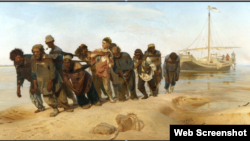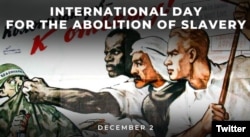The United Nations celebrates December 2 as the International Day for the Abolition of Slavery. On that day in 1949, the U.N. General Assembly adopted a convention prohibiting human trafficking and exploitation.
This year, the Russian Foreign Ministry marked the day with a Twitter post featuring a propaganda cartoon from the era of Soviet dictator Josef Stalin. A blue archival stamp is visible on the cartoon below a sign that reads “Colonizers to answer!”
On top of the original cartoon, the ministry added a fresh new caption reading “International Day for the Abolition of Slavery.” The ministry tagged official accounts of the African Union, African representatives at the U.N. and African national governments.
The tweet said: “Our country was one of the few that never engaged in the slave trade.”
That is false.
Kholopstvo (a Russian name for slavery) was practiced in the Muscovite state, precursor to the Russian Empire, from the Middle Ages to 1723, when Peter the Great abolished it.
By the laws of kholopstvo, as laid out in Russkaya Pravda, an 11th century compilation of the state legal norms, a kholop was not the “subject” but the “object” of rights. There was no punishment for killing one’s own kholop, and only a small monetary fine for killing of someone else’s kholop.
The three common reasons for becoming a kholop were, according to Russkaya Pravda: captivity followed by a trade for goods or money; being sold into kholopstvo as a punishment for crime; or kabal’noe kholopstvo, a bankruptcy or inability to pay taxes or debts. Marrying a kholop meant becoming one, and children born to unfree parents were kholops.
Kholops were used as a hard-labor force, mainly on farms and in the fields. On average, a single landlord owned 600 kholops.
Another form of unfreedom – serfdom – was the legalized ownership of people as a labor force, and it existed in the Russian Empire from its formation until 19th century. Serfs were bought and sold. The abolition of serfdom in 1861 freed approximately 10.5 million people.
In his 1961 book “Lord and Peasant in Russia: From Ninth to Nineteenth Century,” Princeton University historian Jerome Blum describes serfdom as slavery. He and other historians note that the difference between slavery and serfdom was that slaves belonged to their masters, while serfs belonged to the land and were sold and bought together with land.
But by the 1720s, the legal distinction between slaves and serfs in the Russian Empire had been eliminated.
In the late 19th century, Russian newspapers were still printing advertisements like, “A serf girl with a little child is on sale for 50 silver rubles and 10 rubles worth of assignations (paper money),” the Russian news agency Lenta.ru wrote in 2016, in a piece headlined: “350 years of slavery: Who in Russia suffered most from serfdom and its abolition.”
Women sold cheaper than men, and in the Novgorod region (central Russia) one could buy a female serf for five rubles and a goose for 1.25 rubles. A healthy man would cost 400 rubles, Lenta.ru wrote, citing historian Sergey Kocherezhko.
Russian landlords were notorious for cruel treatment of their serfs. The death of a serf after a beating or any sort of punishment or abuse by the master was not considered a crime under Russian law. Young women died twice as often as men.
In 1768, Daria Saltykova, a landlady who owned farms and mansions in the Moscow, Volgograd and Kostroma regions, was sentenced to life in a monastery for “torturing and murdering” her serfs.
Saltykova was 26 years old when her husband died, and she inherited some 600 serfs. In the seven years that followed, Saltykova killed 138 of them, mostly women and young girls accused of not washing the floors and the clothes clean enough.
Saltykova would douse the victim with boiling water or singe her hair. The offenders were then flogged by grooms, starved and tied naked outdoors in the winter.
Saltykova’s was one of the “very few” cases that made it to court, which most often would punish the serfs who complained of being mistreated, not their masters. Landlord brutality and the murder of serfs were “very common,” according to the Russian language history website History.ru.
Though the Russian Foreign Ministry’s Soviet poster condemned imperialism, Russia itself has been notorious for brutal colonial policies that drove entire nations to extinction while reducing others to the status of “ethnic minorities.”
In his recently published book “Failed State: A Guide to Russia’s Rupture,” British-American scholar of Russian history Janusz Bugajski argues that Russia remains an empire and that Moscow’s ongoing military aggression in Ukraine is colonial.
Answering Polygraph.info questions about the Russian Foreign Ministry’s claim, Bugajski said:
“All Russian empires have engaged in various forms of slavery. The Tsarist empire imposed an onerous form of serfdom, akin to slavery, for the peasant masses.
“The Soviet-communist empire established the Gulag system, which enslaved millions of people as free labor and enforced a system of ‘internal colonization’ to extract maximum produce from an impoverished peasantry. It also deported entire nations to Siberia, the Far East, and the High North as free labor to develop remote regions.
“Both the Tsarist and Soviet empires also engaged in national genocides and the eradication of non-Russian cultures. This colonial empire has yet to be fully dismantled.
“National republics and regions in the Russian Federation continue to be exploited for their natural resources and cheap labor. Moscow has hidden its colonial slavery from the outside world while posing as the defender of colonized people from Western imperialism. But as the invasion of Ukraine has revealed, racism, colonialism, and imperialism are deeply embedded in Russia’s history and culture.”







